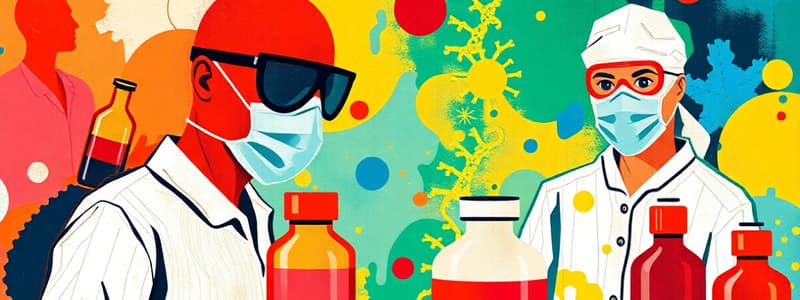Podcast
Questions and Answers
What is the requirement before an individual can work independently with procedures?
What is the requirement before an individual can work independently with procedures?
- Verification of proficiency in the procedure (correct)
- Participation in a group training session
- Completion of an externally accredited course
- Submission of a written report about the procedure
Which of the following must be included in mandatory training for all personnel?
Which of the following must be included in mandatory training for all personnel?
- Knowledge of financial management principles
- Advanced technical skills specific to their roles
- Operational management strategies in health care
- Understanding of laboratory hazards and associated risks (correct)
What should be done with competencies to ensure continuous improvement?
What should be done with competencies to ensure continuous improvement?
- They should be evaluated only at the annual performance review
- They should remain unchanged throughout employment
- They must undergo regular reviews and refreshers (correct)
- They can be ignored if the individual has experience
What level of biological containment hood is required for processing samples to prevent infectious agents from transmitting?
What level of biological containment hood is required for processing samples to prevent infectious agents from transmitting?
What must happen as soon as new procedures or technologies become available?
What must happen as soon as new procedures or technologies become available?
What should be done to ensure safety during operations where splashing may occur?
What should be done to ensure safety during operations where splashing may occur?
What is the recommended alternative when substituting dangerous glassware?
What is the recommended alternative when substituting dangerous glassware?
What is an appropriate action for managing sharp materials?
What is an appropriate action for managing sharp materials?
What should NOT be done with syringes containing needles?
What should NOT be done with syringes containing needles?
What is the correct procedure for disposing of specimens and cultures?
What is the correct procedure for disposing of specimens and cultures?
Which type of glove is known for offering superior resistance to chemicals and gases, making it suitable for handling hazardous materials?
Which type of glove is known for offering superior resistance to chemicals and gases, making it suitable for handling hazardous materials?
What is one primary drawback of thicker gloves compared to thinner disposable gloves?
What is one primary drawback of thicker gloves compared to thinner disposable gloves?
In which settings are neoprene gloves primarily used?
In which settings are neoprene gloves primarily used?
Which gloves are considered more suitable for healthcare applications due to their powder-free nature?
Which gloves are considered more suitable for healthcare applications due to their powder-free nature?
What characteristic is common to gloves designed to be ambidextrous?
What characteristic is common to gloves designed to be ambidextrous?
What is a primary benefit of using glass stoppers for long-term storage of reagents?
What is a primary benefit of using glass stoppers for long-term storage of reagents?
Which component of a refrigerated microcentrifuge is responsible for maintaining the desired temperature during operation?
Which component of a refrigerated microcentrifuge is responsible for maintaining the desired temperature during operation?
Which accessory is used to minimize spills when dispensing liquids from reagent bottles?
Which accessory is used to minimize spills when dispensing liquids from reagent bottles?
What feature might screw caps have to enhance their sealing properties?
What feature might screw caps have to enhance their sealing properties?
What purpose do labels serve on reagent bottles?
What purpose do labels serve on reagent bottles?
What is the primary function of the monochromator in an optical system?
What is the primary function of the monochromator in an optical system?
In which mode does the spectrophotometer measure the fraction of incident light that passes through the sample?
In which mode does the spectrophotometer measure the fraction of incident light that passes through the sample?
Which of the following light sources is typically used for ultraviolet measurements in an optical system?
Which of the following light sources is typically used for ultraviolet measurements in an optical system?
Which mode of measurement in spectrophotometry is specifically utilized for quantitative analysis based on Beer-Lambert’s law?
Which mode of measurement in spectrophotometry is specifically utilized for quantitative analysis based on Beer-Lambert’s law?
What feature of modern spectrophotometers aids users in managing spectral data and performing calculations?
What feature of modern spectrophotometers aids users in managing spectral data and performing calculations?
Flashcards are hidden until you start studying
Study Notes
Safety Precautions for Handling Biological Agents
- Wear protective gear to shield mouth, eyes, and face during operations that may cause splashing.
- Secure hair to prevent contamination during lab procedures.
- Use dressings to cover broken skin to avoid exposure to biological agents.
- Strictly prohibit pipetting by mouth to avoid ingestion or contamination.
Handling Glassware and Sharp Objects
- Prefer plastic alternatives over glassware whenever possible to minimize breakage risk.
- Use scissors with blunt or rounded tips instead of pointed ones to enhance safety.
- Regularly inspect glassware for breakage, cracks, or chips and discard any damaged items promptly.
- Employ ampoule openers for safe handling of ampoules.
Syringe and Sharp Material Management
- Opt for blunt syringe needles and engineered safety devices to reduce injury risk.
- Never use syringes with needles as pipetting devices.
- Avoid capping, clipping, or removing needles from disposable syringes.
- Dispose of sharp materials in puncture-proof containers with sealed covers, filling them no more than three-quarters full.
Disposal of Biological Materials
- Use leak-proof containers with securely fastened lids for disposing of specimens and cultures.
- Position waste containers at workstations to ensure proper disposal practices.
Training and Competency Requirements
- Competency assessments help identify specific training needs for lab personnel.
- Regular reviews of competencies and refresher training are essential for maintaining safety standards.
- Implement mandatory safety and security training covering hazards, safe procedures, and emergency preparedness.
Biological Samples and Personal Protective Equipment
- Treat all biological samples as potentially infectious, handling them in a Biosafety Level 2 containment hood.
- Choose appropriate gloves based on the task: latex for general use, vinyl for mild chemicals, neoprene for chemicals and oils, and butyl rubber for hazardous materials.
- Glove thickness varies from thin disposable types to heavy-duty options; thicker gloves provide more protection but less dexterity.
- Avoid powdered gloves due to contamination risks and prefer powder-free options in healthcare settings.
Glassware and Bottling Components
- Use ground glass stoppers for long-term storage as they offer excellent chemical resistance.
- Implement screw caps for quick, secure sealing of reagent bottles, ensuring additional leak resistance with liners or gaskets.
- Employ pouring rings to minimize spills when dispensing liquids from bottlenecks.
- Labels on reagent bottles enhance identification and organization.
Refrigerated Microcentrifuge
- A refrigerated microcentrifuge is crucial for centrifuging small biological samples while maintaining temperature control.
- Features a built-in refrigeration system to regulate chamber temperature during operation, essential for temperature-sensitive materials.
- Components include compressor, condenser, evaporator, and a temperature control unit to ensure precise temperature management.
Spectrophotometry
- Spectrophotometers measure light absorption using a light source, monochromator, sample compartment, and detector.
- Advanced models may use various light sources for broader spectral coverage.
- Users can analyze samples at specific wavelengths or across a wavelength range for comprehensive data through different measurement modes (absorbance, transmittance, concentration).
- Built-in software assists with data acquisition and analysis, facilitating graphing and report generation.
Studying That Suits You
Use AI to generate personalized quizzes and flashcards to suit your learning preferences.




